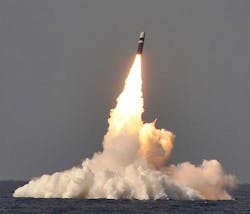Navy asks Lockheed Martin to build more Trident II D5 submarine-launched nuclear missiles
Officials of the U.S. Navy Strategic Systems Programs (SSP) office in Washington are asking the Lockheed Martin Space Systems segment in Sunnyvale, Calif., to provide new procurement of Trident II (D5) missile production and D5 deployed systems support.
Navy leaders have put a substantial amount of time, money, and resources into Trident D5 missile production over the past two years. President Donald Trump has said one of his highest military priorities is to revitalize the nation's nuclear forces.
Just three months ago Lockheed Martin won a $95.4 million contract for Trident II D5 ballistic missile production and support, and near the same time the Charles Stark Draper Laboratory Inc. in Cambridge, Mass., won a $58.6 million order for Trident D5 MK 6 guidance system production.
In July 2016 Lockheed Martin won a $21.8 million contract for long lead items to support the fiscal 2017 Trident II D5 missile production schedule, and around the same time the company won an $8.3 million order for a cyber security update to information technology (IT) applications unique to fleet ballistic missile systems such as the Trident D5.
Related: Nuclear ballistic missile command and control technology still a prime military concern
In March 2016 Draper Lab won a potential $163.6 million contract to build, test, verify, and recertify Trident missile inertial measurement units, electronic assemblies, and electronic modules.
The Trident II D5 is one of the most advanced long-range submarine-launched nuclear missiles in the world. It is the primary U.S. sea-based nuclear ballistic missile, and is deployed aboard U.S. Navy Ohio-class ballistic missile submarines.
The U.S. Navy operates 14 of these ballistic missile submarines, each of which can carry as many as 24 Trident II missiles. Although the Trident II is designed to carry as many as 12 multiple independently targetable reentry vehicle (MIRV) warheads, current treaties reduce this number to four or five.
Each Trident II missile has a range of 4,000 to 7,000 miles. The Trident II D5 was first deployed in 1990 and is scheduled to remain in service until at least 2027.
The Navy started the D5 Life Extension Program in 2002 to replace obsolete components using as many commercial off-the-shelf (COTS) parts as possible to keep costs down and to enhance the missile's capability. Draper Lab is in charge of upgrading the Trident II's guidance system, and has been working on this project since 2005.
Related: Draper Lab continues program to enhance accuracy of submarine-launched nuclear missiles
In practice, the Trident II missile's inertial measurement system receives targeting data from computers aboard the submarine. The inertial measurement unit then transmits signals to the D5 flight-control computer and converts them into steering commands to keep the ballistic missile on target.
The missile's post-boost control system maneuvers the missile in flight to observe stars for the missile's celestial navigation subsystem, which updates the inertial system in flight.
Lockheed Martin also is integrating the Trident II onto the next-generation ballistic submarine designs of the U.S. and United Kingdom by adapting the Trident II missile and reentry subsystems into the common missile compartment for the Ohio replacement and United Kingdom successor programs.
The Ohio replacement is being designed to replace the Navy's fleet of Ohio-class ballistic missile submarines. The United Kingdom successor program, meanwhile, will replace the Royal Navy's fleet of Vanguard-class ballistic missile submarines.
Related: Navy plans cyber security upgrades for fleet of submarine-launched nuclear missiles
The U.S. Navy today operates 18 Ohio-class submarines -- 14 of which carry the Trident nuclear missile. Four Ohio-class subs have been modified to carry conventionally armed long-range cruise missiles.
The Ohio-class submarine has been in commission since 1981, and this class is scheduled to be decommissioned and replaced starting in 2029. The United Kingdom Vanguard-class ballistic missile submarine has been at sea since 1993. The Royal Navy operates four Vanguard-class subs.
On this contract modification Lockheed Martin will do the work in Sunnyvale and Palo Alto, Calif.; Cape Canaveral, Fla.; Kings Bay and Atlanta, Ga.; Silverdale and Poulsbo, Wash.; Magna, Utah; Gainesville, Va.; Baltimore and Elkton, Md., and other locations, and should be finished by September 2017.
For more information contact Lockheed Martin Space Systems online at www.lockheedmartin.com/us/ssc.html, or the Navy Strategic Systems Programs office at www.ssp.navy.mil.
Learn more: search the Aerospace & Defense Buyer's Guide for companies, new products, press releases, and videos
